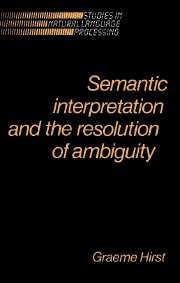7 - The Semantic Enquiry Desk
Published online by Cambridge University Press: 18 December 2009
Summary
A year working in Artificial Intelligence is enough to make one believe in God.
—Alan PerlisIntroduction
In this chapter, I will show how structural disambiguation may be added to the Paragram–Absity–Polaroid Words system. I will do this in two stages. First, I will consider the present version of the system and the structural ambiguities that it handles, a small subset of those that I listed in section 6.2. (Not all of the sentence types that I listed can even be parsed by the present Paragram grammar.) The disambiguation methods will include a synthesis of some of the ones that we saw in section 6.3, as well as my own. Then, second, I will consider methods for extending the system's present limited range of abilities.
Although Paragram is basically a Marcus parser (see section 1.3.2), it has a somewhat different approach to semantics from that taken by Parsifal (Marcus 1980), which we saw in section 6.3.2. The two are similar in that they both assume the existence of a semantic process that they can ask for guidance when they need it. However, unlike Parsifal, Paragram is a trifle pajanoid: it will never attach anything to anything, whether an ambiguity is possible or not, without first asking for permission from semantics. The semantic process that Paragram uses is called the Semantic Enquiry Desk (SED); it is the operation of this process that we discuss in the remainder of this chapter.
At present, Paragram knows about two types of structural ambiguity for which it requires assistance from the SED: prepositional phrase attachment and gap finding in relative clauses. In the following sections, I will show how the SED handles each of these.
- Type
- Chapter
- Information
- Semantic Interpretation and the Resolution of Ambiguity , pp. 164 - 186Publisher: Cambridge University PressPrint publication year: 1987



